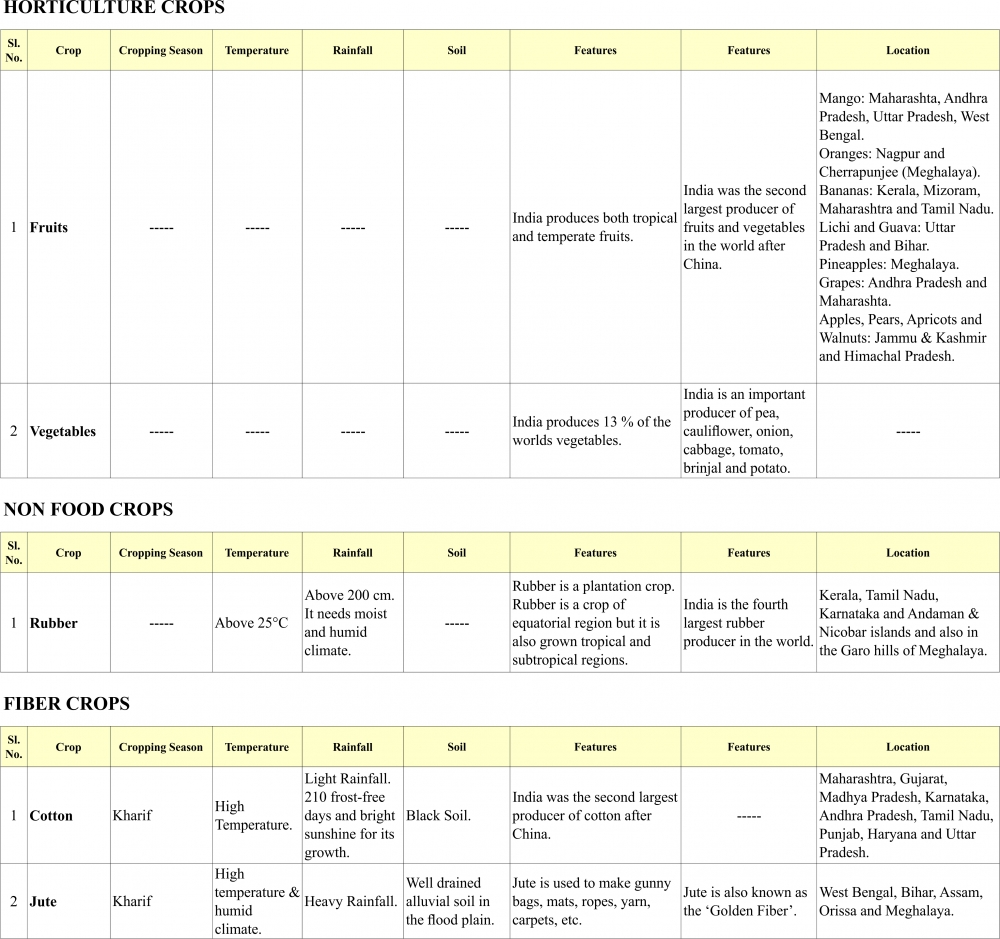Agriculture
Introduction
India is an agricultural powerhouse, with two-thirds of its population engaged in farming. Agriculture is the primary economic activity, providing food, raw materials for industries, and export products like tea, coffee, and spices.
Types of Farming
India's diverse physical environment, technology, and socio-cultural practices have led to various farming systems:
Primitive Subsistence Farming: Practiced in remote areas, this involves small plots, basic tools, and family labor. It relies on monsoon rains and natural soil fertility. Farmers practice shifting cultivation (slash and burn), moving to new areas when soil fertility declines. Examples include Jhumming in the Northeast, Pamlou in Manipur, and Dipa in Chhattisgarh.
Intensive Subsistence Farming: Common in densely populated areas, this labor-intensive system maximizes output from limited land using high doses of fertilizers and irrigation.
Commercial Farming: This focuses on high productivity using modern inputs like HYV seeds, chemical fertilizers, and pesticides. The degree of commercialization varies by region. For example, rice is a commercial crop in Haryana and Punjab but a subsistence crop in Odisha.
Plantation Agriculture: A type of commercial farming where a single crop is grown on a large area, requiring capital-intensive inputs and migrant labor. Examples include tea in Assam, coffee in Karnataka, rubber, sugarcane, and bananas.
Cropping Patterns
India has three cropping seasons:
Rabi: Sown in winter (October-December) and harvested in summer (April-June). Major crops include wheat, barley, peas, gram, and mustard. North and northwestern states like Punjab, Haryana, and Uttar Pradesh are major producers.
Kharif: Sown with the monsoon onset and harvested in September-October. Major crops include paddy, maize, jowar, bajra, tur (arhar), moong, urad, cotton, jute, groundnut, and soybean. Rice-growing regions include Assam, West Bengal, coastal Odisha, Andhra Pradesh, Telangana, Tamil Nadu, Kerala, and Maharashtra.
Zaid: A short season between rabi and kharif (summer months). Crops include watermelon, muskmelon, cucumber, vegetables, and fodder crops.
Major Crops:


Technological and Institutional Reforms
After independence, India focused on institutional reforms like collectivization, landholding consolidation, and the abolition of the zamindari system. The Green Revolution and White Revolution (Operation Flood) aimed to improve agricultural practices. Further reforms in the 1980s and 1990s included crop insurance, Grameen banks, and cooperative societies to provide loans to farmers. The government also introduced schemes like Kisan Credit Card (KCC) and Personal Accident Insurance Scheme (PAIS) to benefit farmers.
Bhoodan-Gramdan Movement
Vinoba Bhave initiated this movement to promote land redistribution. It involved voluntary land donations from landowners to landless farmers. This movement is also known as the Blood-less Revolution.
V. Ramachandra Reddy (1905-1986): A social worker who played a role in initiating the Bhoodan movement in Pochampally. He was the first to donate land (80 acres) as part of this movement.